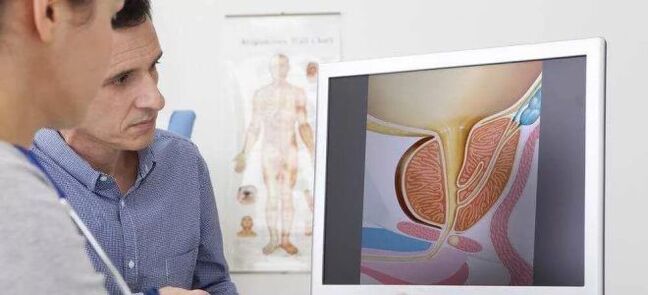
Prostate problems usually first appear in men of reproductive age. Their causes and types are different. The most common pathology is prostatitis - inflammation of the prostate gland. The insidiousness of the disease lies in the fact that the symptoms of prostatitis in men are latent for a long time.
What is the prostate gland in men?
The prostate gland is an accessory sex gland in the male reproductive system. In its shape, it resembles a chestnut. The mass of this organ is about 12–20 g, in structure, the prostate is similar to a sponge, consisting of many small cavities in which the secretions of the prostate are formed. Through many small ducts, bile enters the urinary tract during intercourse.
The body is divided into 3 regions:
- skull;
- medium;
- tail.
According to the doctors' observations, the disease mainly affects the nucleus pulposus and tail. Malignant tumors are localized directly in them. Given these features, if pathology is suspected, specialists will examine these areas of the prostate among the first.
Where is the prostate gland located?
The prostate gland in men is activated and begins to grow at the onset of puberty. This process is controlled by sex hormones. This androgen-dependent organ is located below the bladder. Through the prostate passes through the original part of the urethra. The excretory ducts of the prostate gland open to the urethra.
Considering the whole pelvis, we can say that the prostate is centrally located. It wraps around the bladder neck and proximal urethra. With its apex, the prostate makes contact with the pelvic diaphragm, on which the external urethral sphincter is located. On the back, the thyroid gland with the rectal canal, through which a digital examination of the prostate is usually performed.
%20in%20men.jpg)
What is the prostate gland responsible for?
The functions of the prostate gland are as follows:
- Produces the fluid that forms the liquid part of semen.
- Converts testosterone to its active form, dihydrotestosterone.
- The formation, together with the muscles of the bladder neck, of the internal sphincter, is involved in the process of urination.
- Involved in the process of ejaculation.
Prostatitis - types
Before addressing the main symptoms of prostatitis in men, it is necessary to consider the types of existing diseases. Prostatitis, depending on the form of violation, the clinical picture is divided into the following types:
- Acute prostatitis- a severe inflammation of the prostate gland, which develops due to a bacterial infection.
- Chronic bacterial prostatitis- is characterized by a slow course, periods of exacerbations alternating with remission.
- Chronic pelvic pain syndrome- a difficult-to-diagnose form of prostatitis, manifested by constant pain in the pelvic region.
- Asymptomatic chronic prostatitis- no clear clinical picture, discovered incidentally, according to urinalysis results.
- Prostatitis granuloma- considered as a side effect of drug treatment for other diseases. Prostate tissue is gradually replaced by connective tissue.
Prostatitis - causes
Prostatitis in men can have many different causes. In most cases, however, they were associated with stronger sexual disdain for their health.
Among the factors that provoke the development of pathology, doctors call:
- infections of the genitourinary system;
- circulatory disorders in the pelvic organs due to a sedentary lifestyle;
- no prolonged sex, interrupted intercourse;
- reduced local immunity;
- frequent hypothermia;
- hormonal imbalance in the body;
- lack of vitamins and minerals;
- non-compliance with the rules of personal hygiene.
Infectious prostatitis
Prostatitis of an infectious nature is the result of the penetration of pathogenic microorganisms into the prostate gland. This process can be acute or chronic.
Trigger factors play an important role in the development of infectious prostatitis, including:
- severe hypothermia of the body;
- stressful situations;
- increased physical activity;
- bad habits (nicotine, alcohol);
- Diabetes;
- hypothyroidism;
- HIV.
Prostatitis is not contagious
Chronic prostatitis in most cases is not contagious. The factors that contribute to the development of this form of pathology are not fully understood.
Among the specialists may be the following:
- irregular sex life;
- hormonal disorders in the body;
- increased body weight;
- sedentary type of work;
- constant stress;
- genetic predisposition;
- constipation.

Signs of prostatitis in men and its symptoms
Symptoms of prostatitis in most cases go unnoticed for a long time. Periodic pain in the inguinal region, a violation of sexual function, many men consider as a temporary phenomenon. In 90% of cases, the development of prostatitis is manifested by a decrease in sexual activity, problems with ejaculation and difficulty urinating. In the acute form, the disease is accompanied by a general deterioration of health.
When an exacerbation of prostatitis occurs, the symptoms in men are as follows:
- increased body temperature;
- general weakness;
- increased sweating;
- pain in the perineum, spreading to the anus and pubic bone;
- difficulty urinating.
The first symptoms of prostatitis
The first symptom of prostatitis in men that you need to pay attention to is sexual dysfunction. A man complains of a worse erection or its complete absence. Ejaculation is also disturbed, the ability to reach orgasm is impaired. The same symptoms of prostatitis in young men negatively affect sex, so they soon begin to avoid catching their lover's eye. This leads to depression, constant stress and anxiety, which aggravates the situation.
Symptoms of prostatitis - what is pain?
Painful prostatitis occurs mainly when developing in an acute form of the disease. Their localization may vary. Therefore, back pain caused by prostatitis is overcome by about 50% of patients. In most cases, men experience severe pain in the perineum and scrotum, which spreads to the sacrum.
The intensity of pain can vary: from aching, uncomfortable sensations to pain that doesn't allow you to sleep at night. Increased pain may be noted with intercourse, with excessive sexual activity, with ejaculation. Symptoms of prostatitis in men often appear among the first.
Peeing with prostatitis
Considering the inflammation of the prostate gland, the symptoms of the disease, among other signs, doctors distinguish a violation of the process of urination.
Patients often complain of the following features:
- frequent urination;
- lack of feeling of bladder emptying after going to the toilet;
- difficulty urinating.
Characteristic symptoms:
- In most cases, it all starts with the fact that a man cannot empty his bladder normally. The prostate gland becomes inflamed, increases in volume and gradually compresses the urethra.
- Progressive inflammation leads to the development of bladder neck sclerosis. As a result, the patient frequently wants to go to the bathroom.
- The chronic form is characterized by nocturia: a man is forced to get out of bed and go to the bathroom in the middle of the night.
- All this is accompanied by unpleasant sensations in the groin area. Sometimes, these are the only symptoms of chronic prostatitis.

Allocate for prostatitis
Talking about the symptoms that can be observed with prostatitis, doctors also name discharge from the genital tract among the possible manifestations of the disease. The most common of these disorders is an enlarged prostate. It occurs with a decrease in the tone of the prostate gland and indicates the presence of an inflammatory process in the gland. In such cases, discharge occurs after the act of urinating or defecating.
The consistency of the discharge from the genital tract resembles a thick, milky liquid. When in the prostate gland, in addition to inflammation, there are also infectious agents, the color of the discharge turns transparent with a yellowish color. At the same time, the man noted discomfort in the anus and itching in the urethra.
Allocation is usually more noticeable during the day, after active exercise, performing prostate massage. Similar symptoms of prostatitis in men compel to consult a doctor and undergo an examination.
temperature for prostatitis
Prostatitis in men is always accompanied by canker sores. Body temperature with a similar disease often rises to 39 degrees.
A man noticed the appearance of the following symptoms:
- sharp pain in the lower abdomen;
- pain in the perineum;
- pain during bladder emptying;
- discomfort and discomfort during bowel movements.
Temperature in most cases occurs only at the beginning of the inflammatory process. Over time, after taking antipyretic and anti-inflammatory drugs, its normalization is observed. The lack of treatment and medical care during this period will lead to the progression of prostatitis and the transformation of the disease into a chronic form.
Why is prostatitis dangerous?
Doctors recommend starting treatment at the appearance of the first clinical symptoms of the disease. For this, a man needs to contact a urologist if he is suspected of having the disease. The consequences of prostatitis can be varied: from sexual dysfunction to problems with conception and secondary infertility. The probability of developing such a pathology is 40% without appropriate therapy. The most terrible complication is prostate tumor - a tumor of a malignant nature.
Other negative effects include:
- neurosis;
- abscess;
- depression and apathy.

























